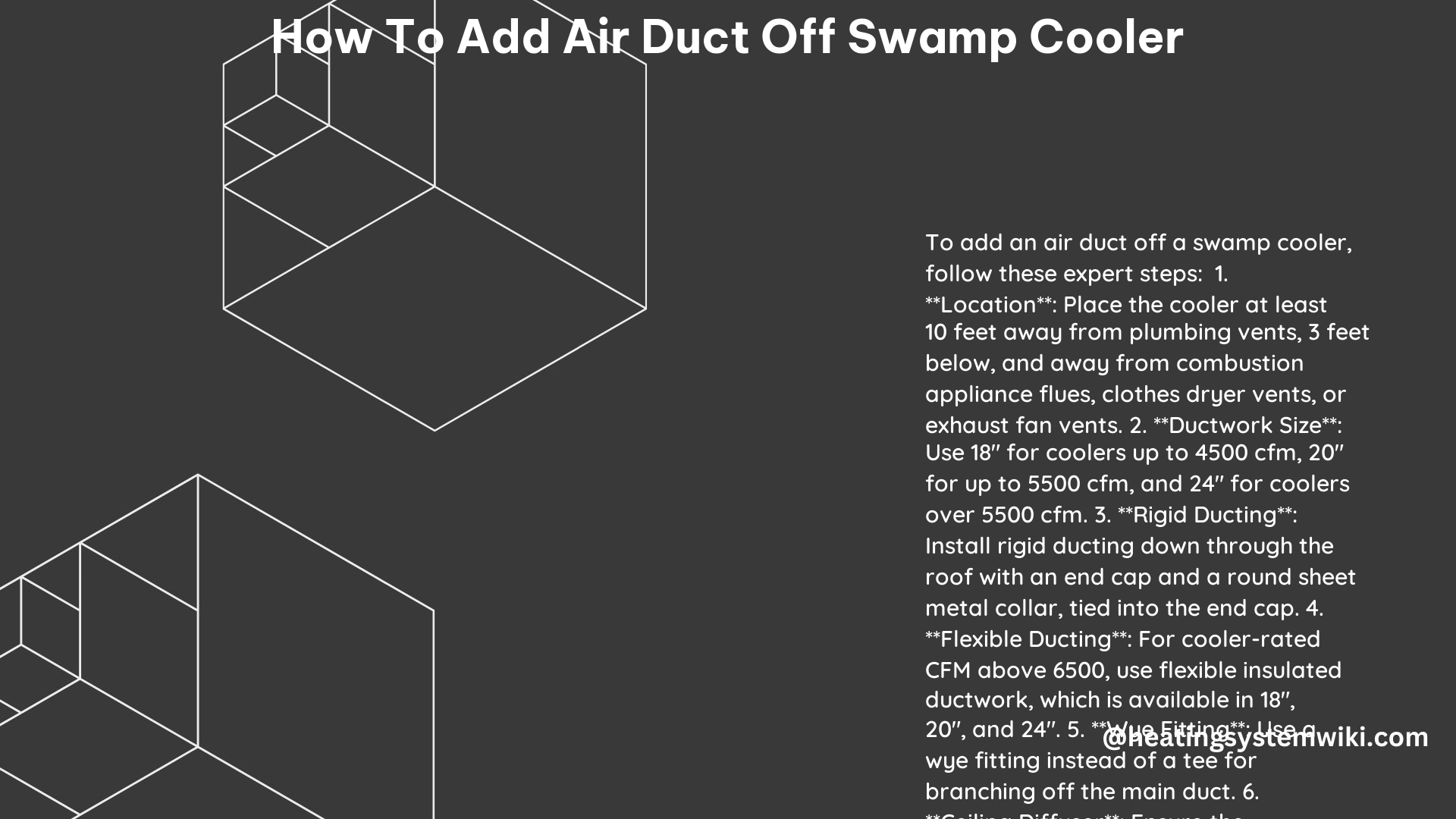Adding an air duct off a swamp cooler requires careful consideration of various factors, including the type of ducting, the size of the duct, and the location of the installation. This comprehensive guide provides advanced hands-on details and technical specifications to help you successfully complete this project.
Type of Ducting: Rigid vs. Flexible
When it comes to the type of ducting, you can choose between rigid and flexible options. Each has its own advantages and disadvantages:
Rigid Ducting:
– Made of sheet metal, offering superior durability and longevity.
– Comes in standard sizes of 18″, 20″, and 24″ in diameter.
– Recommended for swamp coolers with airflow capacities up to 5,500 CFM.
– Requires more specialized installation techniques, such as cutting, fitting, and sealing the metal sections.
Flexible Ducting:
– Constructed with insulated plastic, making it easier to install and maneuver.
– Available in the same standard sizes as rigid ducting: 18″, 20″, and 24″ in diameter.
– Suitable for swamp coolers with airflow capacities up to 4,500 CFM (18″ duct), 5,500 CFM (20″ duct), and above 5,500 CFM (24″ duct).
– Provides better insulation and can help reduce energy losses, but may be less durable over time.
When selecting the type of ducting, consider the specific requirements of your swamp cooler, the accessibility of the installation area, and your personal preferences in terms of ease of installation and long-term performance.
Duct Size: Matching the Swamp Cooler Capacity

The size of the duct you choose should be based on the size and airflow capacity of your swamp cooler. Most common swamp coolers require the following duct sizes:
| Swamp Cooler Capacity | Duct Size |
|---|---|
| Up to 4,500 CFM | 18″ x 18″ |
| 4,500 CFM to 5,500 CFM | 20″ x 20″ |
| Above 5,500 CFM | 24″ x 24″ |
It’s important to ensure that the duct size matches the swamp cooler’s capacity to maintain optimal airflow and cooling performance. Oversizing or undersizing the duct can lead to inefficient operation and potential issues with the system.
Location of the Installation: Avoiding Problematic Areas
When installing the air duct off your swamp cooler, it’s crucial to avoid certain problematic areas on the roof. Specifically, you should not install the ductwork and cooler:
- Spanning the peak or ridge of the roof
- In a valley
These locations can create several challenges:
-
Aesthetics: Installations spanning the roof peak or in a valley can be visually unappealing and detract from the overall appearance of your home.
-
Flashing and Weather Sealing: Maintaining a proper weather seal and effective flashing in these areas is extremely difficult, increasing the risk of leaks and water damage.
-
Structural Integrity: Positioning the ductwork and cooler in these locations may compromise the structural integrity of the roof, potentially leading to long-term issues.
To avoid these problems, always offset the ductwork and cooler installation from the peak, ridge, or valley of the roof. This will not only improve the aesthetics but also ensure better flashing and weather sealing, as well as maintain the structural soundness of your roof.
Installation Process: Framing the Ductwork
To install the air duct off your swamp cooler, you’ll need to create a framework for the ceiling or roof. Follow these steps:
-
Position the First Cut: Position the first cut of the ductwork against the side of an existing truss, and layout the penetration from there. Ensure that the layout aligns well with the roof truss configuration.
-
Frame the Remaining Sides: Frame in the other three sides of the ductwork to provide a secure mounting point for the ductwork and the ceiling diffuser.
-
Secure the Ductwork: Fasten the ductwork securely to the framed structure, using appropriate fasteners and sealants to prevent air leaks.
-
Install the Ceiling Diffuser: Once the ductwork is in place, install the ceiling diffuser to distribute the cooled air throughout the desired space.
By carefully planning the layout and framing the ductwork, you can ensure a stable and well-integrated installation that meets the specific requirements of your swamp cooler and home.
Additional Considerations
If you’re using the same ductwork as an existing air conditioner, make sure that the joints are fastened securely to prevent air leaks. Additionally, you may need to install a barometric damper to regulate the airflow and prevent backdraft, which can occur when the swamp cooler is not in use.
Remember to consult local building codes and regulations to ensure that your installation meets all necessary requirements and safety standards.
Conclusion
Adding an air duct off a swamp cooler requires careful planning and attention to technical details. By understanding the type of ducting, the appropriate duct size, the optimal installation location, and the proper installation process, you can successfully integrate your swamp cooler with a ductwork system that delivers efficient and effective cooling throughout your home.
Reference:
1. Swamp Cooler Installation | Hvac – Perfect Home Hvac Design
2. Can a swamp cooler use the same ductwork as an existing air conditioner? – DoItYourself.com
3. How To Install Swamp Cooler Ducting – MMI Home Improvement
